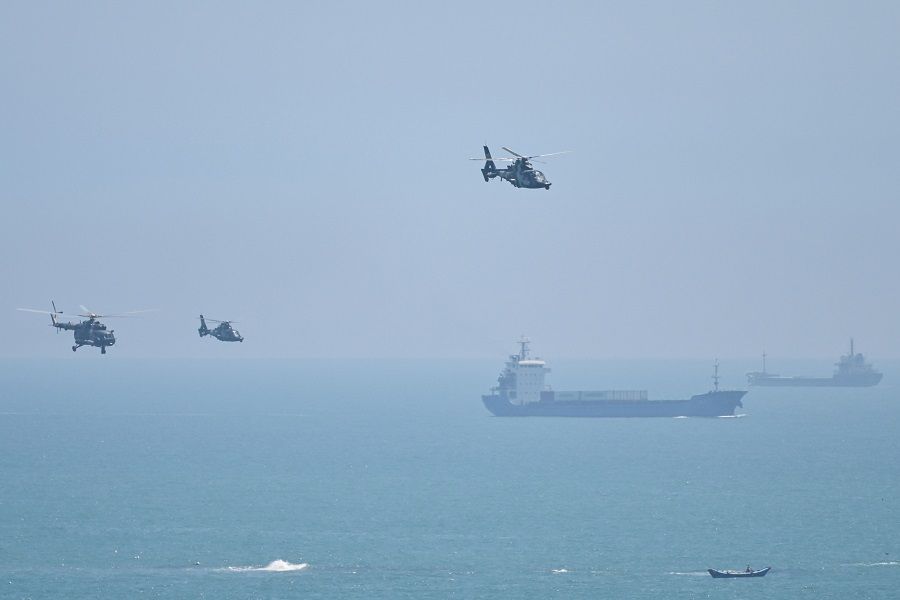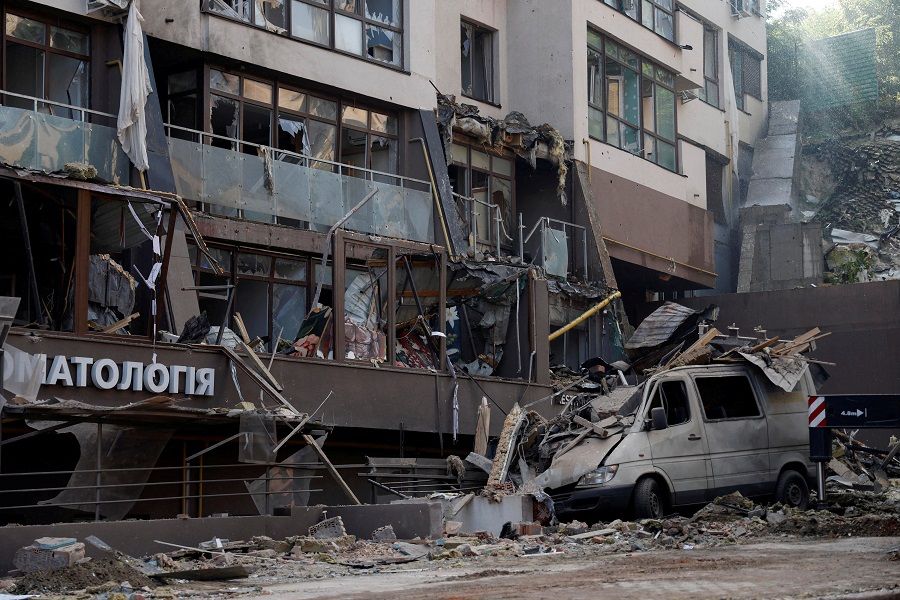In the China-US-Russia confrontation, it is military power that counts in the end

China, the US and Russia are at the epicentre of world turmoil in 2022. The US is rallying the West against China and Russia while the latter two are joining forces to retaliate, culminating in a vicious circle of attacks and counterattacks. This confrontation is strategically significant as the outcome will change the fate of mankind. At the moment, the most direct form of confrontation we are seeing is the show of military power.
Russia's losses in the Ukraine battlefield
When Russia invaded Ukraine on 24 February, Russian President Vladimir Putin believed that Ukraine would easily fall, but six months have passed and Ukraine is in ruins. Roughly 9,000 Ukrainian troops have been killed and nearly 1,000 children have died from violence or have been injured. More than 5,500 civilians have lost their lives, over 7,800 are injured, and the number of refugees has exceeded 6.6 million. While Russian troops have occupied about 20% of Ukraine's territory, over 25,000 Russian soldiers have died in the war.
So far, the trajectory of the Russia-Ukraine war indicates that Russia will not win, but Ukraine's lost territory will be hard to recover as well as their troops are badly outnumbered. Nonetheless, the grit and determination shown by the Ukrainians have given them the edge in defeating the Russians. The Ukrainians are also backed by almost all of Europe and the US, who have been a major supplier of military aid and source of support in winning the war.
The Russia-Ukraine battlefield has become a runway for the US and Russia to flex their military muscles, and from which the loser will withdraw from the global stage.

From a technical standpoint, Russia's military equipment has performed poorly in this information war, putting a dent in Russia's international reputation. The Russians failed to gain air superiority and its Su-30 and Su-35 combat aircraft were shot down by man-portable weapons made by the West. On the streets of Kyiv, damaged and burnt Russian tanks and armoured vehicles are on display.
However, Russia's massive bomb attacks have caused severe casualties in Ukraine - at its peak, Russian forces could fire up to 10,000 artillery rounds a day, while Ukrainian forces could only muster up 1,000 artillery rounds. But after Ukraine acquired the M142 High Mobility Artillery Rocket System (HIMARS) and the M270 multiple-launch rocket system, the Russians lost their advantage. Ukrainian forces started bombing Russian air bases, ammunition and supply depots, going as far as the Crimea.
The Russia-Ukraine battlefield has become a runway for the US and Russia to flex their military muscles, and from which the loser will withdraw from the global stage. The large amount of military aid sent from the West is a testament to their will to defeat Russia, and the comprehensive national strength they have behind it to back it up. When diplomacy fails to prevent war, major powers turn to flexing their military prowess.
Taiwan unperturbed by PLA's show of military prowess
Military power was also on parade in recent Taiwan Strait tensions. On 20 August, a Washington Post article revealed insider information about US House Speaker Nancy Pelosi's Taiwan visit, confirming that mainland Chinese officials had issued warnings to the US at all levels as soon as they knew about the visit.
An unnamed senior White House official revealed that, following the various warnings that Chinese officials made to their US counterparts, Chinese President Xi Jinping asked US President Joe Biden during their phone call to "find a way to keep Pelosi from visiting".

But the unnamed official said that Biden could not oblige - Congress is an independent branch of government, and Pelosi, as with other members of Congress, makes her own decisions about foreign trips. Biden warned Xi not to take provocative and coercive actions if Pelosi were to travel to Taiwan. This in fact refutes the claim that Biden had tried to dissuade Pelosi from making the trip to Taiwan - the US will never show weakness to China.
... the PLA fighter jets gave up after failed attempts, because they were "all jammed by electronic interference by the American aircraft strike group".
The US resorted to military means to "escort" Pelosi to Taiwan given the failed attempts for diplomatic communication. The US military provided Pelosi with security assessments and protection, deploying USS Ronald Reagan and her strike group back to the South China Sea. National Security Council coordinator John Kirby asserted that Beijing's reaction to Pelosi's Taiwan visit was "exactly in line" with what the US had anticipated. Washington was also prepared to respond to the situation.
According to the South China Morning Post, military sources and defence analysts pointed out that Chinese and US forces were locked in a reconnaissance and electronic warfare tussle prior to and after Pelosi's Taiwan trip. The People's Liberation Army (PLA) mobilised naval and air forces in several locations to conduct "full tracking and surveillance" involving fighter jets and Type 055 destroyers. However, the PLA fighter jets gave up after failed attempts, because they were "all jammed by electronic interference by the American aircraft strike group".
After Pelosi left Taiwan, the PLA conducted large-scale military exercises around Taiwan and even fired missiles over the island. From a technical perspective, the PLA's military exercises provided the best opportunity for the outside world to observe the integrated combat capabilities of the Eastern Theater Command, the Rocket Force and the Strategic Support Force. Meanwhile, the US collected intelligence from signals, communications and electronic sensors.
"Taiwan has already gotten used to it." - Taiwanese commentator Joyce Yen

The Taiwanese people seem unperturbed by the military exercises. A Taiwanese Public Opinion Foundation survey released in August found that over 78% of Taiwanese aged over 28 are not afraid of the mainland's military exercises around the island, with 45% of them saying that they are "not afraid at all", and only around 17% of them said that they were. Taiwanese cultural commentator Joyce Yen stated that while Taiwan-US relations will continue to warm up and tensions in the Taiwan Strait will continue to rise, "Taiwan has already gotten used to it".
US military's upper hand
Pelosi's Taiwan visit and the PLA's military exercises have prompted more visits to the island by US politicians. US Senator Marsha Blackburn arrived in Taiwan on 25 August, becoming the third US congressional delegation to visit Taiwan since Pelosi's visit - after Democratic senator Ed Markey and Indiana Republican governor Eric Holcomb. The mainland's actions against Taiwan have reinforced the US Congress's stance against China, accelerating the legislative process for the Taiwan Policy Act of 2022.
The political tussle surrounding Pelosi's Taiwan visit bears testament to the formation of two major camps in the world.

Based on international public opinion, the mainland's supporters include Russia, Pakistan, North Korea, Laos, Cambodia, Iran, Cuba and Nicaragua. Opponents of the mainland are mostly the Western powers, with G7 foreign ministers and the EU issuing a joint statement reiterating their concern over the "threatening actions" announced by China, especially "live-fire exercises and economic coercion".
Furthermore, a joint statement issued by the foreign ministers of the US, Australia and Japan implies that the "one China" policy would only apply under certain circumstances, given the use of the words "where applicable" in the statement.
The China-US military tussle over Taiwan shows that the US military still has the upper hand and that Taiwan will not be deterred by the PLA's military drills.
The political tussle surrounding Pelosi's Taiwan visit bears testament to the formation of two major camps in the world. The China-US military tussle over Taiwan shows that the US military still has the upper hand and that Taiwan will not be deterred by the PLA's military drills.
Indeed, based on the situation in the Russia-Ukraine war, the US military will certainly defeat Russia. Russia's arms exports have declined in 2022 as more of Russia's arms clients turn to the US. The military tussle between China, the US and Russia in crucial times has also prompted more countries to join the arms race.

The accession of weapons-manufacturing powerhouses such as Finland and Sweden to NATO will only boost NATO's military power - how can Russia, which has become isolated in Europe, regain former Soviet territory?
The situation has developed beyond Putin's expectations; the world will wait and see if he is put on trial for war crimes.
Arms race in East Asia
In East Asia, Japan is unhappy with the five ballistic missiles fired by the mainland that landed in its exclusive economic zone (EEZ). Nikkei senior staff and editorial writer Katsuji Nakazawa alleged that the order to launch ballistic missiles into Japan's EEZ must have come from Xi - although this claim is debatable.
Chinese military expert Song Zhongping pointed out that China had deliberately released the news of the PLA's ballistic missiles landing in Japan's so-called EEZ - if Japan interfered in the Taiwan issue, Japan's self-defence forces and US bases in Japan would be targeted by China.
East Asia's arms race is quickly picking up speed. Taiwan plans to raise its total military expenditure by almost 14% next year, while the US and South Korea are resuming large-scale joint military drills.
Is Japan intimidated? The missile firings will only bolster the Japanese politicians' commitment to fulfil late former Japanese Prime Minister Shinzo Abe's last wishes - to revise the constitution and rearm Japan - and substantiate Abe's comment that "a Taiwan emergency is a Japanese emergency". Japan will indeed draw closer to Taiwan - in an open confrontation of the mainland's one China principle, the Japanese government invited Taiwan to send representatives to Abe's state funeral.

East Asia's arms race is quickly picking up speed. Taiwan plans to raise its total military expenditure by almost 14% next year, while the US and South Korea are resuming large-scale joint military drills. Efforts to denuclearise North Korea have come to nought after the Kim Jong-un administration witnessed the fate of Libyan leader Muammar Gaddafi after he gave up his nukes, as well as the deterrent effect of Putin waving his nuclear flag. Kim would rather have his people tighten their belts than cut back on military spending. South Korea will more likely than ever continue to deploy the Terminal High Altitude Area Defence (THAAD) missile defence system.
China has kept itself busy as well. Global Times reported that China will develop a blue-water navy by 2035 to "match the country's international status and better defend its interests". This feeds the idea that a country's international standing is backed by its military power and that the law of the jungle still holds given the great powers' focus on military power. At this crucial time, the UN exists in name only - international order must be restructured, and this is perhaps part of "profound changes unseen in a century".
Related: China normalising military measures in the Taiwan Strait | Implications of the Russia-Ukraine war for the People's Liberation Army | Closer military ties in China-Russia power play | Is there still hope for peaceful reunification in the Taiwan Strait? | Will China and Russia join hands to push for an alternative world order?
